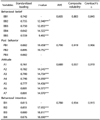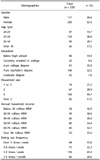1. Ministry of Health and Welfare, Korea Centers for Disease Control and Prevention. Korea Health Statistics 2016: Korea National Health and Nutrition Examination Survey (KHANES VII-1). Cheongwon: Korea Centers for Disease Control and Prevention;2018.
4. Kim TH, Lee EK, Han E. Food away from home and body mass outcomes: taking heterogeneity into account enhances quality of results. Nutrition. 2014; 30:1015–1021.

6. Wright KB, Mazzone R, Oh H, Du J, Smithson AB, Ryan D, MacNeil D, Tong X, Stiller C. The influence of U.S. chain restaurant food consumption and obesity in China and South Korea: an ecological perspective of food consumption, self-efficacy in weight management, willingness to communicate about weight/diet, and depression. Health Commun. 2016; 31:1356–1366.

7. Kang J, Jun J, Arendt SW. Understanding customers' healthy food choices at casual dining restaurants: using the value-attitude-behavior model. Int J Hosp Manag. 2015; 48:12–21.

8. Jeong JY, Ham S. Application of the Health belief model to customers' use of menu labels in restaurants. Appetite. 2018; 123:208–215.

9. Amrein MA, Rackow P, Inauen J, Radtke T, Scholz U. The role of compensatory health beliefs in eating behavior change: a mixed method study. Appetite. 2017; 116:1–10.

10. Hagger MS, Trost N, Keech JJ, Chan DK, Hamilton K. Predicting sugar consumption: application of an integrated dual-process, dual-phase model. Appetite. 2017; 116:147–156.

11. Hsu CL, Chang CY, Yansritakul C. Exploring purchase intention of green skincare products using the theory of planned behavior: testing the moderating effects of country of origin and price sensitivity. J Retailing Consum Serv. 2017; 34:145–152.

12. Smith JR, Terry DJ, Manstead AS, Louis WR, Kotterman D, Wolfs J. The attitude-behavior relationship in consumer conduct: the role of norms, past behavior, and self-identity. J Soc Psychol. 2008; 148:311–333.

13. Ajzen I. The theory of planned behavior. Organ Behav Hum Decis Process. 1991; 50:179–211.

14. Ajzen I, Fishbein M. Attitude-behavior relations: a theoretical analysis and review of empirical research. Psychol Bull. 1977; 84:888–918.

15. Kim E, Ham S. Development and validation of a measure of consumer behaviors toward nutritional labeling in restaurants. J Foodserv Bus Res. 2017; 20:595–610.

16. Malek L, Umberger WJ, Makrides M, ShaoJia Z. Predicting healthy eating intention and adherence to dietary recommendations during pregnancy in Australia using the theory of planned behaviour. Appetite. 2017; 116:431–441.

17. Kim E, Ham S, Yang IS, Choi JG. The roles of attitude, subjective norm, and perceived behavioral control in the formation of consumers' behavioral intentions to read menu labels in the restaurant industry. Int J Hosp Manag. 2013; 35:203–213.

18. Jun J, Arendt SW. Understanding healthy eating behaviors at casual dining restaurants using the extended theory of planned behavior. Int J Hosp Manag. 2016; 53:106–115.

19. Shin YH, Im J, Jung SE, Severt K. The theory of planned behavior and the norm activation model approach to consumer behavior regarding organic menus. Int J Hosp Manag. 2018; 69:21–29.

20. Seo HS, Lee SK, Nam S. Factors influencing fast food consumption behaviors of middle-school students in Seoul: an application of theory of planned behaviors. Nutr Res Pract. 2011; 5:169–178.

21. Seo S, Kim OY, Shim S. Using the theory of planned behavior to determine factors influencing processed foods consumption behavior. Nutr Res Pract. 2014; 8:327–335.

22. Han H, Kim Y. An investigation of green hotel customers' decision formation: developing an extended model of the theory of planned behavior. Int J Hosp Manag. 2010; 29:659–668.

23. Kim YJ, Njite D, Hancer M. Anticipated emotion in consumers' intentions to select eco-friendly restaurants: augmenting the theory of planned behavior. Int J Hosp Manag. 2013; 34:255–262.

24. Steptoe A, Pollard TM, Wardle J. Development of a measure of the motives underlying the selection of food: the food choice questionnaire. Appetite. 1995; 25:267–284.

25. Wang YF. Modeling predictors of restaurant employees' green behavior: Comparison of six attitude-behavior models. Int J Hosp Manag. 2016; 58:66–81.

26. Bamberg S, Ajzen I, Schmidt P. Choice of travel mode in the theory of planned behavior: the roles of past behavior, habit, and reasoned action. Basic Appl Soc Psych. 2003; 25:175–187.

27. Ouellette JA, Wood W. Habit and intention in everyday life: the multiple processes by which past behavior predicts future behavior. Psychol Bull. 1998; 124:54–74.

28. Sutton S. Predicting and explaining intentions and behavior: how well are we doing? J Appl Soc Psychol. 1998; 28:1317–1338.

29. Feunekes GI, Gortemaker IA, Willems AA, Lion R, van den Kommer M. Front-of-pack nutrition labelling: testing effectiveness of different nutrition labelling formats front-of-pack in four European countries. Appetite. 2008; 50:57–70.

30. Verbeke W, Vackier I. Individual determinants of fish consumption: application of the theory of planned behaviour. Appetite. 2005; 44:67–82.

31. Ajzen I. Nature and operation of attitudes. Annu Rev Psychol. 2001; 52:27–58.

32. Bucher T, Müller B, Siegrist M. What is healthy food? Objective nutrient profile scores and subjective lay evaluations in comparison. Appetite. 2015; 95:408–414.

33. Nunnally JC. Psychometric Theory. 2nd ed. New York, NY: McGraw-Hill;1978.
34. Bagozzi RP, Yi Y. On the evaluation of structural equation models. J Acad Mark Sci. 1988; 16:74–94.

35. Fornell C, Larcker DF. Evaluating structural equation models with unobservable variables and measurement error. J Mark Res. 1981; 18:39–50.

36. Hair JF Jr, Black WC, Babin BJ, Anderson RE. Multivariate Data Analysis. 7th ed. Englewood Cliffs, NJ: Prentice-Hall;2010.
37. Cheng S, Lam T, Hsu CH. Testing the sufficiency of the theory of planned behavior: a case of customer dissatisfaction responses in restaurants. Int J Hosp Manag. 2005; 24:475–492.

38. Chan EK, Kwortnik R, Wansink B. McHealthy: how marketing incentives influence healthy food choices. Cornell Hosp Q. 2017; 58:6–22.
39. Jun J, Kang J, Arendt SW. The effects of health value on healthful food selection intention at restaurants: considering the role of attitudes toward taste and healthfulness of healthful foods. Int J Hosp Manag. 2014; 42:85–91.

40. Khare A, Inman JJ. Habitual behavior in American eating patterns: the role of meal occasions. J Consum Res. 2006; 32:567–575.

41. Conner M, Norman P, Bell R. The theory of planned behavior and healthy eating. Health Psychol. 2002; 21:194–201.

42. Kahneman D. Thinking Fast and Slow. New York, NY: Macmillan Publishing;2011.
43. Talukdar D, Lindsey C. To buy or not to buy: consumers' demand response patterns for healthy versus unhealthy food. J Mark. 2013; 77:124–138.

44. Cantor J, Torres A, Abrams C, Elbel B. Five years later: awareness of New York city's calorie labels declined, with no changes in calories purchased. Health Aff (Millwood). 2015; 34:1893–1900.

45. Elbel B, Mijanovich T, Dixon LB, Abrams C, Weitzman B, Kersh R, Auchincloss AH, Ogedegbe G. Calorie labeling, fast food purchasing and restaurant visits. Obesity (Silver Spring). 2013; 21:2172–2179.







 PDF
PDF ePub
ePub Citation
Citation Print
Print







 XML Download
XML Download